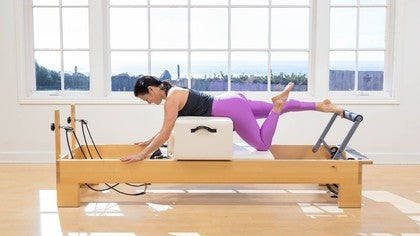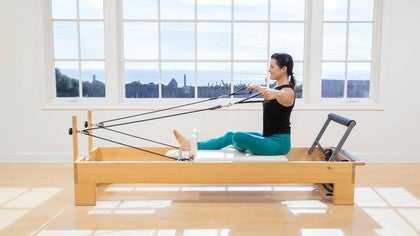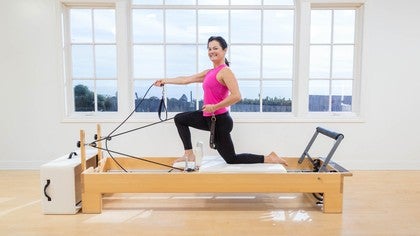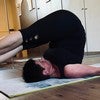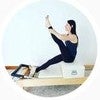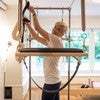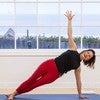Description
About This Video
Transcript
Read Full Transcript
Thanks for joining me today. We're going to tune in to imbalances and also flow through a nice workout. So I invite you to use any types of self-correcting tips that you may be privy to. I also invite you to watch my tune in tips that will help you kind of figure out how to adjust your body throughout this workout. And I'll refer to some of those tips throughout the workout.
Most importantly, give yourself grace to enjoy the movement and enjoy the practice. And also remember, whenever pushing yourself or doing something that feels new or different, there should always be a little bit of a wiggle room, meaning you shouldn't be so stretched that it hurts and you shouldn't be working so hard that there's tension. So let's tune into those ideas and see where we land today. Okay. I'd like you to begin sitting on your sits bones and just kind of wiggle in a little bit to those sits bones, perhaps scoop some flesh from one side, scoop the flesh from the other side, scoop the flesh from the back and see if you can really feel that resting point where you're sitting on all three points of your pelvis right here, your sits bones, and there's some connection of your pubic bone, close your eyes and breathe with me, inhaling through the nose.
And if it suits you, please exhale through the nose. Practicing the nasal breathing will help us to down register the nervous system and calm the nervous system is what I really wanted to say. And let's begin with a small roll down. The head goes forward. The upper back, the hands can just slide down the legs as you continue to roll forward until you feel where you need to stop today.
Pay attention to there being weight on both of your feet. Pay attention to relaxing your neck, inhale here, and then use an exhale perhaps to roll yourself up one vertebra a time, let your hands graze past your legs, and then come to that upright position once again, feel your pelvis, your ribs, or your chest and your head stacked and floating in space, inhale again. Exhale, notice if there's a sticky point in your neck, soften it. Notice if you feel stickiness in your back, your upper back, breathe into it. Notice if you feel stickiness in your low back, your hips, the backs of your legs, inhale and exhale.
Rolling yourself up. This time, as you come to that upright position, continue on, lift your heart, open through your collarbones and send your head back a little bit, creating just a little bit of thoracic extension, and then look around. Use your eyes. Come back to center, adding arms. We're gonna roll down, relax the neck, relax the shoulders.
Roll up. This time allow the arms to come all the way up to the ceiling, open wide. And then we'll roll down one more time. Inhale, just notice where you feel sticky. Maybe you don't feel sticky at all.
Maybe this just feels like a nice opening through the heart. Nice little bit of movement, open the arms wide. And settle here. So now rotation, look to your left with your eyes, move your head around and notice where you maybe get stuck. Where do you feel tension?
I often have to think about my left side. I've got one hand on the back of the reformer, one hand on my leg, and I'm gonna continue to rotate and see if I can breathe into a little bit more rotation. And unwind eyes go the other way, head, shoulders, one hand on the reformer, one hand on my leg, and I'm just gonna create a little bit more rotation with my breath. And let's do that again. Purposefully have the arms low here because I don't want the shoulders to get in the way, eyes, head, rotate perhaps a little more, breathing in and breathing out.
And unwind, and one more time. I'm just enjoying and smiling looking at the view here. It's such a pleasure to be here, the warm sun on my face, and unwind. So let's lie down on our reformers. I've got my spring set for footwork.
So I'm on three reds and a blue. If you find you would like to have a little bit less spring, that's fine. Three reds and a blue works for me. Take a few moments to settle in here. Find your neutral pelvis.
Use any tools you need to wiggle into place, open through your chest, roll your head side to side. Check in that you're centered and balanced here. And then with your feet just resting on the bar, keep the thigh exactly where it is and take your right leg to straight. Just notice how you feel. Do that two more times and then do the other side.
So keeping the pelvis still, leg to straight, just notice how you feel. So all I'm noticing right that I've got a little bit of restriction on my left hamstring, but not on my right. Maybe you notice something, maybe you don't, Let the legs sway side to side just one time. I'm gonna take my arms out to the side and just relax my arms here, letting the chest tissue stretch and the bicep stretch, legs are just kind of going side to side. And then settle in.
We're gonna lift the legs, lift the head and chest, create a round shape. So I'm in like a rolling like a ball shape, but I'm gonna really not think much about my shoulders. Let my shoulders stretch, let my neck stretch and just see if I can get a little tiny rocking and rolling without changing my shape of my body here. So I'm engaging my abdominals with my breath here. And with this shape, hamstrings are engaged.
I'm not thinking about where my legs are. Meaning the feet are not pointed. The knees are not bent a certain way. I'm just enjoying this and then release and settle in for some footwork now. So once again, check in with your pelvis, check in with your ribcage, check in with your head, check in with your feet.
I'd like you to begin with your heels just below the bar. So the bar is kind of just above the heel in a little sweet spot that's gonna help you keep your feet soft, and then begin extending your legs to straight. So we're gonna endeavor to keep that pelvis nice and neutral. So perhaps use your hands on your pelvis. Perhaps use your hands on your hip crease.
Perhaps use the press method to keep the upper quad a little bit out of it and just check it in, and make sure that both of your feet are contributing equally as you breathe in and as you breathe out. So I'm not gonna ask for a specific breath. I'm gonna ask you to slow your breathing down and see if you can inhale and exhale smoothly through your nose in and out. Now think about your right leg, out and in, and then think about your left leg out and in. So I'm putting all the weight on one leg at a time to feel if there's a difference in my strength, if there's a difference in my ability to keep my pelvis still, pause, let's move the feet to the middle, the bar in the middle of the foot, closer to the ball of the foot.
So kind of at the top of the arch, again, we're looking to soften the foot around the bar, check in with your pelvis, is it neutral? Use your hands to help decide, feel the port here from your core without being rigid and then begin moving, breathing and moving. So I often will be heard saying we're just breathing and moving and truthfully today, I just want you to let the breath flow, inhaling when it makes sense, long and deep and exhaling long and deep, and trying to feel that you are working toward this idea of breathing in and out through the nose today, checking in with the backs of the legs and checking in with your legs separately. So can you do one with the right? Can you do one with the left?
Do you feel a difference? Do you wanna move slower? Do you wanna move faster? You can make that choice on your own here, but see if you can really balance out the feeling between the two legs, pause, come in. So the pace is really up to you.
I'm moving somewhat slow, place the balls of the feet now on the bar with the heels slightly lifted and then press your legs out to straighten, hold for a moment. So here you might use that finger sweep to kind of soften across the top of the quad. If that's something that's difficult for you, feel that both feet are working equally here and hopefully at the equal height of heel lift and then gently press in and press out. Again, check in with your upper quads. Is it soft in that hip crease, use your fingers to assess, perhaps you'll press in to create a little bit of an opening through your pelvis and now check in with each leg separately.
So use the right perhaps without changing the pattern and then use the left. And do you feel a difference between your two legs? Perhaps you'll do a couple like that or perhaps you'll stay on one leg for a few repetitions and try to work toward a little bit of balance there, is your pelvis in neutral and are you in fact breathing? Make sure you close it up here with two straight legs or two legs working equally rather. And then we'll gently come in and we'll make a small V position, so the heels are together.
Stay here for just a moment, feel that your feet are comfortably equal on the bar. You might even look up and look at that them. Place your hands on your quads and push away a little bit and ask the thighs to rotate a little more, check in with your hip crease. It should be soft as you initiate it should remain soft, feel that, and then press out and press in. Remember, we're lengthening through the crown of the head, keeping the spine long, trying to complete the movement each and every time.
But if you feel sticky in your upper quad, remember you can use that little finger sweep or you can also use that idea of pulling the tissue and then sweeping. So again, those concepts are highlighted a little bit more in that video that I have posted in the notes here. So if you want a little more information on that, feel free to review that, one more time here, come on in and open V from the heels. So heels are wide on the bar here, let the legs really open and relax and feel where there's stickiness. Where do you feel tight?
For me, I tight in my adducer here and a little bit, I'm having a hard time keeping my pelvis neutral. So I'm gonna spend a couple moments finding where my pelvis needs to be and grounding it down all three points. Then I'm gonna put my hands on my thighs and I'm gonna rotate just a little bit more, specifically for me on my left side, that's where I'm sticky. Why I'm gonna breathe into that for a moment. Let my pelvis perhaps rock side to side a little bit, up and down, iron out the kink.
Now I feel like I can be here. Hopefully you've ironed out any kinks as well. Let's out we go, exhale out to straight, opening across the top of the hip there with a nice neutral pelvis and gently coming in, again, inhaling an exhaling at a pace that suits you today. Focusing on nasal breathing if possible, in through the nose, long, full exhales, softly closed lips with the tongue attached to the root of the mouth. Hopefully, let's do a few more here using both legs equally to the best of your ability.
And then come all the way in. Let's bring the feet close together on the foot bar, balls of the of feet once again, reorganize, make sure your pelvis, your ribcage, everything is where it needs to be, and then press your legs out to straight here. Calf raises, so again, check in before we do the calf raises and make sure you're fully extended through the hip joint. So perhaps use a little bit of that finger sweep and that pulling of the tissue to we open across the hip crease here. If that's tricky for you, I know it is for me.
And then we're gonna press those heels down, keeping length through the spine. So no compression and press those heels up using both feet equally, hopefully, but here I'd like you to check in with your right leg and maybe do one focusing on just the right foot and then check in with your left leg and do one or two focusing on just your left foot and perhaps do a few extra wherever you need to. So maybe you need to focus on both simultaneously. Maybe you need to focus on just one. Maybe you need to do nothing.
Let's hold the legs, the heels high for a moment and go ahead and just bend one knee. I bent my right leg. My left foot is on the foot bar. I'm gonna shift my foot so I can stretch differently. So I like to bring my foot up on the foot bar so that it's just above the heel, the foot bar is just above the heel.
And then I do these little like shimmy movements with my foot, massaging, kneading my foot into the foot bar, sliding it down until I soften the tissue across my foot. And then I find that point where I can just rest in the stretch. So I'm resting in the stretch. I'm checking in with my hip crease, It's open and relaxed. I'm checking in that I have wiggle room here, perhaps with my pelvis softening through the heel, softening through the foot and breathing as well.
Please my friends, let's gently change legs. So once again, my placement here is gonna be so that my other foot, it happens to be my right, the heel, the bar is just above the heel and I'm just gonna sink in for a moment and let the tissue respond on the bottom of my foot. And then I'm just slowly slipping my foot down. I'm just wiggling my foot and kneading the tissue onto the foot bar, and boy, that feels good to me. Now, if that doesn't feel good to you, do something different, just hold the stretch.
I'm getting adjustments in my foot that are necessary. And then when I find that point where it feels very restful for me just to be here with my foot so I'm not gripping with my toes, I'm gonna check in with the hip crease, making sure I'm open, check in with my breath, make sure I have wiggle room in my pelvis. I can be here comfortably, but stably stabilizing, stably. Good, and then just take another breath there. And let's shift back into the stopper.
Go ahead and hug your knees into your chest for just a quick moment and then settle your feet just comfortably on the bar, wherever that makes sense. Check in with your pelvis position and then stretch one leg to straight and the other leg to straight on the foot bar. Shake your legs out a little bit, check in with your pelvis position. So hopefully we are feeling like we're in a neutral position. I just want you to assess your ability to lift the leg without thinking about it.
So pelvis is in neutral, let's take the right leg up to the ceiling and down, just lift a couple times, don't think too much about it. Hopefully pelvis is staying still and then I want you to do some circles and just notice where your pelvis goes. My pelvis wants to move a little bit if I don't think about it, right? Little circles, change sides. So again, I'm just gonna lift my leg up a few times.
Okay, that's pretty easy to do. I do feel tighter on this side, then I'm gonna just like kind of do some little circles and whoa, my pelvis wobbles all over the place. So let's change sides again and let's bring our attention to the left leg that's on the foot bar and really try to spiral in slightly through the leg and ground down through the back of the leg. So I'm really feeling hamstring. I'm feeling my glute and I'm feeling my nice, neutral pelvis here with my other leg lifted.
Now, if I really focus on grounding through that other leg, does the circle, the small circle just become a little bit easier, a little more fluid, for me it does. Hopefully it does for you too. Doesn't matter to me which way you're going. I just want you to feel that, change sides. So press down now through your right leg, into the foot bar, spiral in slightly.
See if you can wake up the glute a little bit, the hamstrings, still keeping the pelvis neutral and then take the other leg up if you haven't already and just do some little circles and do those circles feel easier to do? Yes for me on this side. But this side it's difficult. I've got a weakness there in the hip. So I'm just using my hand to help create fluidity in that circle, in that circle, gently rest that.
And let's get up from here. So give yourself a little hug and then roll yourself perhaps to one side and come upright. So let's move into some abdominal work, reverse knee stretch. If you know me, you know I love that exercise. So we're going to do that with one blue spring, one blue spring for your reverse knee stretch.
So come to your knees please, with your knees all the way together and about four or five inches back from where the shoulder rests are is where I'd like you to begin place your hands on the frame and spend a little bit of time with your legs for a second, energize your legs toward one another and try really hard to keep as much of the top of the foot down as you can, even if the heels have to splay open, but ideally the heels can be together. So as much surface area on the shin as possible, lean into your arms for me, round through your back, take a breath or two or three or four if you need, and then pull that carriage in, hold this rounded shape and focus on your breath. Inhaling up to the back body, stabilizing through the core, allow the legs to go back and pull in. The goal here is that the back stays very, very still. The pelvis stays still and just the legs move.
Do one more like that. Stay, lift your right leg off just a bit so that the foot, the back or the top of the foot can rest on the other foot and the knee is just hovering. Look at your pelvis, make sure it's stable and let's go ahead and pull in and out. When I say stable with the pelvis, when you lift one leg, there's a rotation that sometimes wants to happen. So just check in and make sure that didn't happen.
So you're doing it a few times here with just one leg. Now, put the other leg down and shift the arrangement. So see if you can just lift your left leg up. Rest the top of the foot in the arch of the other foot, keep the pelvis still and pull in and out and just notice how it feels different, notice if it feels different on your two sides. And if you have something to work on, gently, put your two legs down, bring the carriage to rest and sit in a child's pose.
Perhaps letting your forehead rest near the headrest and let your arms either drape over the reformer or they can rest forward on the frame there. If that's more comfortable for you. Roll side to side a couple times, noticing if you feel any tightness in your back, feel free to the tissue or finger sweep if you need to to soften and then bring yourself upright. So here we're gonna use the straps to work our shoulders. I've got it so that my toes are just hanging off the edge a little bit and I'm gonna put the straps on the back of my wrists, okay?
So that I can also hold the straps when needed. We're gonna work one arm at a time here. And what I want you to think about is first, you're gonna bend your right arm and pull your elbow back so that you're holding the spring with your right arm. Take your other arm out to the side. This is the one we're gonna focus on, the one that's straight for now.
So think about really spreading through the collar bones and the shoulder blades, check in with your elbow joint and you want the elbow bend to be so that your arm would bend perfectly parallel with the horizon if you were to bend. So what I'm looking for is that bend of the elbow to be facing straight forward and the point facing straight back. And then I'm gonna slowly give the spring to my left arm, where I'm at there. And I'm gonna keep holding the spring with my left arm and spreading through the collarbone and the shoulder blade. And that actually feels quite challenging for many of us.
Hopefully it feels that way for you. If you keep spreading and reaching, you'll feel more. Oftentimes I see people here lifting up through the shoulder. You wanna think of not pressing the shoulder down, but reaching sort of out and through the underarm. So I'm just gonna change my other hand.
So from the scapula out and through that pinky finger, hold that a little longer, move your head around. Gaze, look, notice what you feel. Breathe, just holding this is quite a lovely challenge, but look for a little bit of wiggle room, a little bit of movement here, and then let's change sides. My left arm is hot. I hope yours is too.
Pull your left arm now back so that you've got this spring with that arm in this row position and then take other arm out to the side and look at it, so look at the elbow, look at where you are and then the idea, the intention is to really reach on the trajectory of your fingers from underneath. So get that spreading sensation and notice where you feel stickiness, where you feel tight, breathe into it, give the spring to that same arm or to that right arm now. Right, and I'm holding it now with just my one straight arm. My other hand is just here reaching, spreading, and then start to look around a little bit and notice where you feel tightness to this side, feels quite easy for me to move my neck, feels quite lovely to hold onto. It doesn't feel that hard, on the other side, it feels much more difficult for me.
So if I were working on my own here, I would go back and do my left arm again. I'll invite you to do that on a different day. Let's take both arms into that wide position, and practice for a moment, spreading through the collar bones and the shoulder blades, check in with your arm position, spread, spread, spread, and then let's just you little tiny movements back and little tiny movements forward. If that doesn't feel right, if that creates tension, then focus just on the spreading and do little rocking movements side to side. Maybe that's a better way to hold it.
It's more of an isometric hold, right? Like this, good. And just one more time, whatever it is you're choosing to do, spread those collar bones and those shoulder blades, move your head around, find a sticky spot and loosen it up and then rest that please. Let's go ahead and put the straps away for now. And then we need to add a spring so we can do some hip work.
So we're gonna have a red and a blue spring for hip work. That's what I like, that's one and a half springs, two springs, one and a half to two springs is ideal, lie back down and settle in for a moment. Remember, although it's nice to work in a timely way, and a speedy way, sometimes also important to make sure that you're settling into your body and that you're finding the right position. So give yourself the grace and the time to do that whenever you're able to, retrieve your straps and then put your feet in the straps please. So press your legs out to straight, and once again, just kind of feel your pelvis, use your fingers, your hands to kind of set things up and make sure you are there.
Feel your ribcage heavy and your head heavy, bend your legs in a bit. And I'm gonna ask everybody to put their hands on their quads for just a moment, that quad crease, and just push away a little bit and feel a little stretch through the low back, a little bit more rotation perhaps through the hips. And then that's the feeling we wanna keep as we to take the spring with the backs of the legs, that hip crease should stay nice and soft. Perhaps put your fingers there, glide the legs out to straight and gently come in. Now you may see that my feet are doing two different things.
I am purposefully not paying attention to what my feet are doing here. And so therefore my feet are doing two different things 'cause I have two different legs. (laughing) So do you. Now some days I'm gonna ask to specifically point the feet or flex the feet, but here I am truly relaxing my legs. As I do my frog movement, trying really hard just to feel the back of the leg.
Not really using the quad very much. It's like, I'm just gliding out with the back of the hip and the leg here, just gliding out and then I'm gonna check in and I'm gonna say, does my right leg feel the same as my left? Yeah, my right leg feels good. What about that left, oh boy. That one's so much harder.
So maybe you'll do a couple with that leg that's harder. Maybe they feel exactly the same. Maybe if they feel exactly the same, you can organize your pelvis differently and things will feel different. Just play with that. Maybe you'll come back to this class and try different things, that's what I hope will happen.
Keep your legs straight ish. Not straight actually, keep them pretty well bent. So I'm in an open diamond shape basically. And now we're gonna work on our hip hinge, once again, put your hands on your pelvis and use your two legs equally to go down, make sure that your belly doesn't pop up into your hands. So you're gonna see where your restriction is.
Do you have one? Can you go all the way down heels into the springs? If not don't. For me, generally I have a restriction on my left hip and I'll pull my tissue and stretch so that I can get all the way down to the spring. So if you feel that it's difficult to keep your pelvis stable, rather than working on holding more, see if you can maneuver things a little differently and allow for a little more range.
Again, the range should be safe and it should feel as though you can do it with both sides. So you might even try doing one leg at a time, which is what I've just done. I'm taking my one leg down and then my other leg down in that same shape, beautiful little hip opener here. Just one more time. So whatever you've done there, whether you're using both legs or not, come to rest, I like the bottoms of my feet to come together and I'll just sit and let my hips open for a couple breaths, rolling side to side.
When I say rolling, I'm just kind of rocking my legs a little bit. Lately, I've been liking doing things that are a little less strict Pilates, a little less organized, just to try to find different things, different feels, and loosen up my body in different ways. So I hope that you're inspired to do the same by this. So here we're gonna move into a variation on the short spine. So if short spine is not comfortable for you, simply stretch and do something else, perhaps some pelvic curls, otherwise we'll press the legs out to straight here.
Now I don't need you to lock your knees straight. I want you to feel that you've got an ease here, that it's pretty easy to be here in the backs of your legs, and make sure you have space from your shoulders in the shoulder rest. So we're gonna change the arm position, rather than keeping the arms down, unless you prefer to, see if you can first hold the shoulder rests. Maybe you can hold the pegs. And maybe if your shoulders are quite flexible, you can reach your hands beyond the pegs and you'll hold the edge just of the reformer frame carriage, rather.
That's just next to the headrest. So see if that works for you and that should feel comfortable. I'm not gonna pull a lot with my arms, but I'm gonna keep my hands there as I fold in. And as I fold into the stopper, I'm getting a really wonderful stretch here and then roll yourself up. And perhaps you're using your hands a little bit, perhaps you're not, stay here in this lifted position for a moment.
And we're gonna try to amplify the flexion of the spine, but without losing the support from the abs. So focus on breathing still with your diaphragm, focus on not jamming all the weight into your head so I can move my neck here. You can hear my voice has changed because my throat is compressed and that's what it's supposed to do. Lengthening through my spine, the front and the back. I'm gonna try bending my legs a couple of times, but the key here is keeping that shape of the spine as you bend and straighten the legs.
So often when people bend, I see a slumping happen and I want you to really keep the shape. So we'll bend just one more time. We'll hold that and then you can roll down. So that's option one, just staying there a little longer to explore your ability to breathe in quite an extreme flexion position. I'm gonna give another option now, okay?
Folding at the hips, we do the same thing on the way up. Feel that beautiful stretch. My arms are back here just to take my arms out of it. Use the abs to roll up, feel the length of the spine there. Now you can rotate your legs to neutral and you can bend your knees and bring your knees in the direction of your forehead.
So you can keep tension on the ropes if that's better, or you can take yourself into a very extreme, stretchier, feels quite nice to me, loosening through my upper back, again, my neck is not compressed. I do not feel tension in my neck. I do feel stretched in my lower neck, upper back, but I can be here quite comfortably and safely with my breath. And then I'm gonna catch the spring. I'm gonna figure out how to safely catch the spring.
I'm gonna extend my legs up to straight again, reset that little turnout position and then bend the knees and lower down, now again, you can pause. You can be finished or you can do one more with me, with one more variation if it makes sense to you, we're gonna fold at the hips again. My back is so loose and lovely and it feels wonderful. And I'm gonna roll myself up. I also feel like I have more access to my abs now and my breath legs come to parallel, right?
Leg stays up, pelvis stays where it is. You should be able to see it, take the other leg down without letting the pelvis shift, without letting the spine change and up. So stabilizing the hamstring, the hip sensors and the abdominals, we're working that forced couple here, do too on the other side, notice where your challenge is. For me, it's much harder to stabilize with my left leg up. I'm quivering like a leaf, you might see it.
That's okay. That's what we're here to do. Bend your knees and roll yourself out of that. And I sure hope that that felt like an interesting thing to play with, just take a pause here. I've got the bottoms of my feet together.
I'm just resting, breathing in and breathing out. That was such an extreme stretch, an extreme position. Just make sure that you feel comfortable and like you've reset before you get up. We'll take the feet out of the straps here and then we'll make our way upright please. Ooh, feels really good.
That's my new favorite way to work my short spine. So we're going to use the long box for the next few pieces here. I'm going to recommend blue spring and we're gonna keep the bar up for now. We're actually gonna use the short box, my bad on that. And this is an interesting way to work the upper body and also the legs, I hope you enjoy it.
It's a bit of a variation on lots of things, an opportunity to explore, so set your box up so it feels pretty even, if you're tall, you're probably gonna wanna put the box over the shoulder rest. I'm pretty small, so I don't need to do that. And we're just going to keep one blue spring on a light spring, and you're gonna climb in. And now one thing that's really nice about this is it gives me some feedback as to where my pelvis is and I don't have to fuss with my hips. So I tend to be tied across the front of my hips.
And it's difficult for me to be in extension sometimes. So this is a great way to feel that. And it's a great way to feel how to extend the hips and the upper back without using the low back too much. Hopefully not all. So just relax over now, if you're well endowed in the front, you might have to find the right spot.
So it doesn't feel uncomfortable. For me, this feels like a really beautiful little bit of traction through my low back. And that's what I'm trying to do. So what I've got going on here is my hip bones and my pubic bone are on the box. My feet, the tops of my feet are just resting on the foot bar.
My knees are together and then I'm gonna play with that arrangement and try to keep it like that. And then I'm gonna just take my hands to the back of my neck and let my head hang and my elbows hang. And that feels like a bit of traction through my low back. It feels really quite nice. And now we're gonna do some work from here.
So reach around and grab your straps, put your hands through the loops and then reach up and hold on to the tape part above the buckle or choke up a little bit, whatever makes sense to you. We're gonna start with upper back work, but keep the legs in this arrangement. So what I'm looking for here is to keep the pelvis pressing and the low back long. So we're not extending through the low back anymore than it naturally is, as we just pull the arms to the box. So I've pulled my two arms to the box.
I'm gonna press into the box and feel that my shoulders are not up by my ears, but they're down. But then they're also open. So I'm spreading my collar bones on my shoulder blades. I'm also bringing attention to keeping my pelvis grounded on the box. Then I'll open my arms up to a T shape and then I'm gonna come down and I'm opening my arms up to a T shape, and then I'm gonna stay there.
Again, I'm pressing my body into the box, keeping my knees together. I'll pull my arms now down toward my body. So it's a variation on pulling straps, taking the lower body out of it. So this is gonna be the option one version. Now you can choose to try one arm at a time here.
It's quite lovely to do, it's quite challenging. Woo. Notice if your whole body changes or not. Woo. Yeah.
Or you can choose to work both arms at the same time. So just notice if it feels different, take a pause. Now, if you decide you would like to work a little bit harder, then I'm going to invite you to wrap your hands around and choke up on the strap so you can get more range, okay? So if the spring already feels heavy, you may not wanna do that. So relax for a moment, let your arms be forward.
Your feet again are resting, so go from the beginning, press your pelvis into the mat. Hip bones and pubic bone. Feel your legs kind of relaxed, but together, knees are resting. Feet will just gently come off the bar here. And now you're gonna pull your arms for me into the box and you're gonna feel neutral spine first.
That's what I'm endeavoring to find, like a neutral long back, okay. Straight back is kind of what I'm looking for. Arms are gonna come up, yeah. And now arms are gonna come all the way forward to straight. So my arms are in alignment with my head and then I'm gonna practice pulling my arms down and then here extending into the upper thoracic extension, all the way forward, keeping the legs somewhat relaxed.
My hamstrings are in fact working, but I'm not using my glutes here, opening through the heart and all the way forward, straight arms up overhead up by the ears and all the way down, thoracic extension. One more time, and beautiful thoracic extension. And let's go ahead and rest that, my arms are nice and fatigued from that. Put the straps away, let your head hang, let your legs relax. This should feel pretty comfortable, if it doesn't, you're welcome to get up and do something else, but we're gonna do one more thing here if it's okay with you, which I'm hoping it is.
So we're gonna work a little bit more on hip extensors from this position, the backs of the legs, and try to identify where we tend to compensate. I know that I have a really hard time using my back left leg without using my low back. So what I've done here is I'm gonna take my hands to my low back and feel my extensors, keep my pelvis grounded, which forces me to use my abdominals a little bit more to help stabilize, and then find that point where I can lift without extending my low back. So I'm lifting my head, I'm using my upper back and I'm gonna stay there, so it's kind of a long back. I'm not looking for a lot of extension.
Maybe a bit of thoracic extension is what we're looking for, but you wanna be able to feel that you can keep that low back kind of out of it for now and now I'm gonna bring my attention to my right leg. So my hand is on the right side of my back and I'm just gonna try lifting my right leg up and down a few times. And I can do that without my back muscles firing. Now I'm gonna bring my hand to my left side. That's a little tricky with my mic pack.
So I'm just trying to get around it here. And then can I lift up without my back muscles working? Now for me, that actually usually quite hard to do. So by really grounding through my hip, by grounding through my or my hip bone. I can feel my hamstring, but my range is quite limited, as I try to lift more, I start to use my low back a little too much.
So I'm just gonna try to practice that range and create a little more. So that's option one. Option two, you're starting to feel a little more comfortable here. We're gonna add a little bit of zest to it. So we find that same point, we feel the pelvis.
We're hopefully just good at it now, right? We can take the arms wide to the side if you want, you can take them down by your side or you can use your arms to support. I like to sometimes use my elbows here just to support, it feels nice, so I can focus on my legs. So I'm going to just tuck my right foot underneath the foot bar and I'm going to press out with my right leg and gently come on in. So my goal here is to feel my hamstring working.
My glute is working too, but without my low back firing up too much. So I'm really just working my hip extensors here. Again, your arms can kind of be where they wanna be. And you can play with this a little bit in different ways. Perhaps you're gonna wanna find a little more extension, perhaps you're gonna wanna find a little more rotation, whatever feels good, now, knees are down, change feet.
So I've got my other foot now, right? And my left foot is on the foot bar. So my attention's gonna go to the left side of my back as I press out. And I try to straighten, and boy, I can feel personally the stickiness back there. So in order for me to fully straighten my leg, it requires some thought because that's a weakness for me going into full extension, so maybe it's easy for you.
Maybe it's not, maybe you feel a challenge. Maybe you feel an imbalance, but just give this, let this be an opportunity to play with this movement a little bit. Just one more time, please. And then we'll put the two knees down. You can find the football with your feet and just kind of walk yourself in.
It should be pretty easy to do, take a little hang over the box, breathing in, And breathing out and let's get ourselves up from there. Okay. So the class would not be complete without a mermaid. That's where we're headed. Let's put our box down.
I like to use one spring, one full spring for my mermaid, A red spring, ideal. And I'll face you first. So for the mermaid, if you're not completely familiar with it, you wanna make sure you've got one leg tucked behind you. You can have the leg all the way up against the shoulder rest, or you can have the foot tucked underneath your glute, depending on your comfort level. One thing I've learned over the years is that it's hard for me to do this position because I'm limited on my internal rotation, but a lot of that is related to where my pelvis is.
So if I have my leg out next to the shoulder rest and I pull my pelvis back where it belongs and I sink, then I'm able to get here a little bit better. So rather than thinking about my hip first, I think about my pelvis first and my hip second. So it's quite an intense stretch through my hip. I invite you to make it comfortable for you. So whatever you need to do here, allow the arm to be straight, straight out from the shoulder, so not behind the shoulder.
And let's just take an easy little shift out to the side with an inhale, use a beautiful exhale perhaps to reach, just make sure you're breathing, hold for a breath or two here. So I like to really push with my supporting arm. So in this direction it was my left arm that started on the bar, so that's my supporting arm. And I'm pushing, with the other hand, I'm reaching over the bar and reaching my ear toward that other arm to get just a little bit more stretch, breathing in and breathing out. And rather than doing a bunch of repetitions, we're just gonna sit with a stretch a little bit and iron out any kinks.
So what I'm currently doing is moving my pelvis a little bit to kind of allow some of that tissue to soften while I breathe. And then we're gonna shift back to the supporting arm. We're gonna unwind, come all the way back to that first position, and again, I try to come back and my hip doesn't really like to move that way. So I consciously have to think about putting my pelvis back where it came from, and then I have a clear path. So perhaps that will help you as well.
Let's do the other side, just one time. That's all we need, sometimes we can do more, but if you go slow and methodical, sometimes all you need is one. So this side is always even harder for me. So I have come to realize it really has a lot to do with where my pelvis wants to go. So if I take the easy way out, I can bring my foot underneath my glute, which is not bad, but it's different.
If I think about where my pelvis needs to be and move it back, then my hip will internally rotate here. And this is no longer stressful on my knee. I feel it more in my hip, still not fully grounded. And that's okay, I feel quite a good stretch here. So sit with that for a couple moments.
Notice where you feel any kinks and try to loosen them, soften them, use your hands to help you out. Your other arm, your supporting arm is going to be straight out from your shoulder and then you can reach away. And again, for me on this tight side, I tend to go to that forward pelvis position, 'cause it's very hard for me to be here. So I have to consciously think about keeping my pelvis back where it belongs and then we're gonna rotate around. And again, I'm consciously thinking about that pelvis back, where it belongs, it's tricky to do, and then we're gonna breathe, pushing with the supporting arm, hooking the other arm and just relaxing into the stretch here, breathing in, and breathing out.
Finding your sticky spots and sending breath to them. Perhaps you'll do little movements with your pelvis. Again, any stretch you're in, any position you're in, there should be a little bit of wiggle room. Find your wiggle room, be curious and be patient and things will show up And then gently unwind, pay attention to where you tend to have to self correct, if you've identified that. If not, keep looking to identify and then I'm gonna swivel around to face you.
And we're going to finish just like we started with our seat equally weighted all three points, settle in feet. Just comfortable. Take your arms up just one time. Take your arms down, roll yourself down and just see how this feels now that we've done a nice little tune in, if you will. Does this feel different, does this feel easier?
I'm moving my pelvis back because I wanna be able to relax here with my head and my neck. I'm gonna sway side to side a couple times, feeling ease in my neck, and then roll yourself up. And let's just do that one more time to finish up today please, roll forward. Head, neck, find your breath. Find your ease, member this should feel good.
Pleasure principle, relax, roll side to side. It doesn't need to be perfect. Figure out where you need to go, and then roll yourself up. Inhaling through your nose and exhaling through your nose. Awaken your eyes if they're closed and hopefully you feel both worked, stretched and relaxed.
That was actually three things. Thank you so much for playing, I'll see you soon.
Pilates with Sarah Bertucelli: Power of Tuning In
Comments
You need to be a subscriber to post a comment.
Please Log In or Create an Account to start your free trial.
